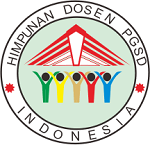PERBEDAAN HASIL BELAJAR SISWA ANTARA MODEL PICTUREN AND PICTURE DENGAN MODEL EXAMPLE NON EXAMPLE DI KELAS V SD NEGERI 066047 MEDAN T.A 2018/2019
DOI:
https://doi.org/10.24114/jgk.v4i1.24828Abstract
Abstract: This study aims to determine the differences in student learning outcomes between the Picture and Picture model and the Example Non Example model in class V. This type of research is a quasi experiment. The research was conducted at SD Negeri 066047 Medan. The research method used was a quasi-experimental research design with a two group pretest posttest design. Sampling in this study was non-probability sampling with the chosen technique, namely purposive sampling. And the determination of the experimental class 1 and experimental class 2 was carried out randomly (random) with a total population of three classes of 80 students. Based on this population, the sample of this study was 52 students in class V-A and V-B. In this case, 24 students of class V-A became experiment 1 class and class V-B became experiment class 2 with 28 students. The instrument used in this study used a test with multiple choice questions. Learning outcomes using the Picture and Picture model in the subject matter of the theme 8 Our Friends' Environment, sub-theme 1 Humans and the Environment and sub-theme 2 Environmental Change in class V SDNegeri 066047 Medan with an average value of 84 , 62 and Standard Deviation of 12.27. Learning outcomes using the Example Non Example model in the subject matter of the theme 8 Our Friends' Environment, sub-theme 1 Humans and the Environment and sub-theme 2 Environmental Change in class V SDNegeri 066047 Medan with an average value of 76.23 and a standard deviation of 16.45. In testing the pre-test data for the two classes, it was found that the data for the two classes were normally distributed and homogeneous. Judging from the average value of increase in the experimental class 1 is 12.19 while the average value of increase in the experimental class 2 is 8.41. Data analysis used t test at the significance level ï¡ = 0.05 with the prerequisite test for normality and homogeneity. The results of the t test of the posttest-pretest difference data obtained tcount = 3.24 while ttable = 2.00. Because tcount> ttable (3.24> 2.00), then H0 rejects and Ha is accepted, which means that student learning outcomes in the subject matter of the 8 Environment of Our Friends, sub-theme 1 Humans and the Environment and sub-theme 2 Environmental Change taught using the Picture and Picture model. better than the student learning outcomes taught by the Example Non Example model. Abstrak: Penelitian ini bertujuan untuk mengetahui perbedaan hasil belajar siswa antaramodel Picture And Picture dengan model Example Non Example di kelas V. Jenis penelitian ini adalah quasi experiment. Penelitian dilaksanakan di SD Negeri 066047 Medan. Metode penelitian yang digunakan adalahquasi experiment dengan desain penelitian two group pretest posttest design. Pengambilan sampel dalam penelitian ini adalah dengan non probability samplingdengan teknik yang dipilih yaitu purposive sampling.Dan adapun penentuan kelas eksperimen 1 dan kelas eksperimen 2 dilakukan secara acak (random) dengan jumlah populasi tiga kelas sebanyak 80 siswa. Berdasarkan jumlah populasi tersebut, maka sampel penelitian ini adalah siswa kelas V-A dan V-B sebanyak 52 siswa. Dalam hal ini siswa kelas V-A menjadi kelas eksperimen 1 sebanyak 24 siswa dan kelas V-B menjadi kelas eksperimen 2 sebanyak 28 siswa. Instrumen yang digunakan dalam penelitian ini digunakan tes dengan soal pilihan berganda.Hasil belajar yang menggunakan model Picture And Picture pada materi tema 8 Lingkungan Sahabat Kita subtema 1 Manusia dan Lingkungan dan subtema 2 Perubahan Lingkungan dikelas V SDNegeri 066047 Medan dengan nilai rata-rata sebesar 84,62dan Standar Deviasi sebesar 12,27. Hasil belajar yang menggunakan model Example Non Example pada materi tema 8 Lingkungan Sahabat Kita subtema 1 Manusia dan Lingkungan dan subtema 2 Perubahan Lingkungan dikelas V SDNegeri 066047 Medan dengan nilai rata-rata sebesar 76,23dan Standar Deviasi sebesar 16,45. Pada pengujian data pre-test kedua kelas diperoleh bahwa data kedua kelas berdistribusi normal dan homogen. Dilihat dari nilai rata-rata peningkatan pada kelas eksperimen 1 sebesar 12,19 sementara nilai rata-rata peningkatan pada kelas eksperimen 2 sebesar 8,41. Analisis data menggunakan uji t pada taraf signifikansi a = 0,05 dengan uji prasyarat normalitas dan homogentias. Hasil uji t data selisih posttest-pretest diperoleh thitung= 3,24 sedangkan ttabel = 2,00. Karena thitung> ttabel (3,24 > 2,00), maka H0 tolak dan Ha diterima, yang berarti bahwa hasil belajar siswa pada materi tema 8Lingkungan Sahabat Kita subtema 1 Manusia dan Lingkungan dan subtema 2 Perubahan Lingkungan yang diajar dengan model Picture And Picturelebih baik daripada hasil belajar siswa yang diajar dengan model Example Non Example.Downloads
Published
2020-01-04
How to Cite
Rangkuti, I., Br Tarigan, A. D. U., & Siregar, A. (2020). PERBEDAAN HASIL BELAJAR SISWA ANTARA MODEL PICTUREN AND PICTURE DENGAN MODEL EXAMPLE NON EXAMPLE DI KELAS V SD NEGERI 066047 MEDAN T.A 2018/2019. JGK (Jurnal Guru Kita), 4(1), 66–72. https://doi.org/10.24114/jgk.v4i1.24828
Issue
Section
Articles
License
Authors published with the JGK (Jurnal Guru Kita) agree to the following terms:
- Authors retain copyright and grant the journal the right of first publication with the work simultaneously licensed under a Creative Commons Attribution License (CC BY-SA 4.0) that allows others to share the work with an acknowledgment of the work's authorship and initial publication in this journal.
- Authors are able to enter into separate, additional contractual arrangements for the non-exclusive distribution of the journal's published version of the work (e.g., post it to an institutional repository or publish it in a book), with an acknowledgment of its initial publication in this journal.
- Authors are permitted and encouraged to post their work online (e.g., in institutional repositories or on their website) prior to and during the submission process, as it can lead to productive exchanges, as well as earlier and greater citation of published work. (See The Effect of Open Access)




























